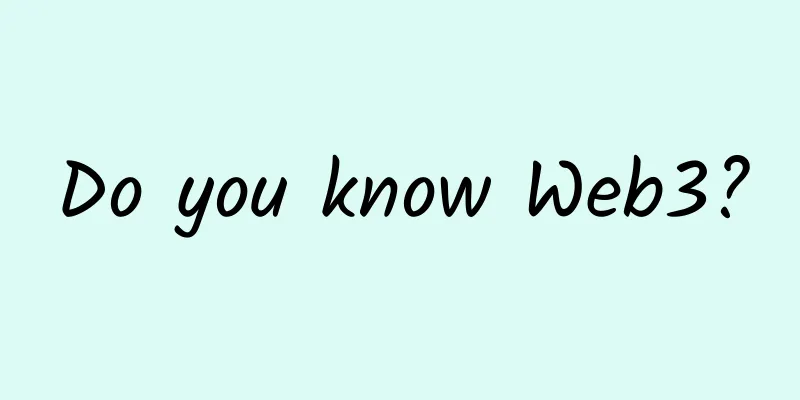Do you know Web3?

Part 01 What is Web3?Before we learn about Web3, let’s take a look at the basic concepts of Web1.0 and Web2.0. Web1.0 is characterized by reading. Users view whatever content the website provides to them. This process is a one-way behavior with almost no interaction. Web1.0 lasted from about 1991 to 2004. During this period, many portal websites were born. There were two major portals abroad, Yahoo and Google, and three major portals in China, Sina, Sohu, and NetEase. They attracted users to click and watch by displaying various web page information. With the development of Internet technology, we have ushered in the Web 2.0 era. The rise of websites such as blogs, online communities, and social media platforms has enabled close interaction and collaboration between websites and users. Users are both consumers (browsers) of websites and creators of website content. Users can generate content on the platform in the form of UGC (Internet term for User Generated Content), such as posting pictures and texts on social media platforms, uploading videos on video websites, and so on. Figure 1 The difference between Web1.0, Web2.0, and Web3 If Web1.0 is a "read-only" Internet, and Web2.0 is a "read+write" Internet, then Web3 is a "read+write+own" Internet. Web3 adds property rights on the basis of Web2.0. Various computing terminals are connected in a decentralized way, and do not rely on various server-based databases. The most notable feature is that it is user-centric, making users' personal information more secure and private. All data will be transmitted between devices, and the entire network world will be freer and more humane. In addition, Web3 can also realize 3D content . With the popularization and development of AR and VR, the content on Web3 will be more "real", giving people an immersive feeling, and the application scenarios will be more diverse. In short, it is not just the simple content and acquisition of Web1.0, nor is it simply the public participation and content provision of Web2.0, but a great integration of the Internet and the daily life of the public. Part 02 What is decentralization?Before we talk about "decentralization", let's talk about what "centralization" is. In the Web2.0 era, the interaction between users and websites must rely on a specific "information intermediary", which can be an application-level platform or a centralized server. In this process, the data and identity information of users on various Internet platforms are separated from each other, and the personal data of users is firmly in the hands of these "information intermediaries". As the "information intermediaries" grow, not only the data monopoly and island effect of the platform are aggravated, but also the personal data of users are at risk of being tampered with, deleted and sold at any time. What's more serious is that as providers and producers of Internet big data, the value generated by individual users is indeed allocated more to "information intermediaries". All data exists on centralized servers and may be abused, hacked or leaked at any time. This is the centralization problem brought by Web2.0. Although Web3 is still in the planning and development stage, the industry has formed some common understandings about it: Web3 must be open, secure, and decentralized, and the platform and application must have native tokens to ensure the automatic settlement of the distribution of interests of all parties during operation. The real Web3 will guide the Internet towards personal control of data ownership, which has overturned the current situation where Internet giants monopolize the Internet discourse power, and fully protect the interests of every Internet user while protecting the personal privacy of users. In the Web3 era, decentralized operation has a more important significance, which is to preserve the "traces of existence" of each user in the Internet world. Old data, favorite music or games will no longer be "disappeared" due to poor platform operation or website iteration. At this stage, network services often have time limits and cannot be retained for a long time, but Web3 can solve this problem. The retention and survival of data is in the hands of each user. Part 03 Application of Web3 TechnologyThe true Web3 era is far from coming, but the Web3 technology that has been implemented in specific scenarios is accelerating the change of people’s online lifestyle. The first is NFT (Non-Fungible Token), which is traded on the Ethereum blockchain. The biggest feature of NFT tokens is their uniqueness. Each NFT is unique and non-interchangeable. People can bind special assets to NFT, which can make many items a digital abstraction and turn them into the owner's "digital assets." On January 1, 2022, the Metaverse platform Ezek and Jay Chou's fashion brand PHANTACi launched the first limited NFT project Phanta Bear, with an upper limit of 10,000. 3,000 were sold within 5 minutes of the launch, and all were sold in about 40 minutes. The hot trading of NFTs has redefined the production, confirmation, pricing, circulation, traceability and anti-counterfeiting of digital assets, and further opened up the art market. Web3 can change the economic form of online life, and naturally it can also influence and give birth to new organizational models. Another practical application of Web3 is DAO (Decentralized Autonomous Organization). Like NFT, DAO is also built on blockchain technology. Compared with traditional organizational forms, DAO is more convenient for global collaboration than traditional companies, and has a lower threshold for participation. In theory, it can exist as long as there is an Internet connection. The biggest advantage of DAO is its "more transparent" nature. This is because all actions and assets in DAO are visible to all members, which greatly reduces the risk of corruption and censorship. In the fields of finance, games, music, etc., Web3 also has specific implementation cases. For example, DeFi (Decentralized finance) refers to financial software built on blockchain; in the field of games, StepN, Axie Infinity and other games that make money by "buying NFT sneakers + running" have created many wealth myths in Southeast Asia and other countries. This trend is also called "GameFi" (=NFT+DeFi+game, that is, financial gamification); in the music circle, many European and American musicians have earned excess wealth far exceeding their fan base by using NFT to release digital albums. Part 04 The future is hereSince the day when blockchain technology was invented, the Web3 era has arrived unstoppably. Technology is constantly being updated and iterated, and the regulatory level is also becoming more and more perfect. Relevant staff of the China Securities Regulatory Commission published an article stating that "strengthening Web3.0 forward-looking research and strategic prediction is undoubtedly of great significance to the construction of my country's future Internet infrastructure." Web3 still faces great controversy. Everything has two sides. We must look at the problem dialectically and recognize it, understand it, and apply it with a positive attitude. 👇 References [1] How to reach the Web3.0 era Zhihu | Chinese Science, first half of the month, 2022, issue 01. [2] Unveiling the veil of Web3.0 Zhihu | Chinese Science, first half of the month, 2022, issue 01. [3] We compiled a Web3 textbook Hedgehog Community. |
<<: Android phone "runs Stable Diffusion" and sets a new record, producing images within 15 seconds
Recommend
Why should users buy your product? 4 ways to steal competitors’ products!
Let me ask you two questions first: If there is a...
With the development of iOS and Android systems today, do they still need to fight to the death?
In the first half of this year, Apple and Google ...
What is the difference between the nine-story and thirteen-story Wenchang Tower?
1. The 13-story Wenchang Tower is undoubtedly cho...
Tik Tok is so popular, but you haven’t started Tik Tok marketing yet?
The first two parts are an analysis of the Douyin...
With a R&D team of thousands of people, why is NIO’s intelligent driving progress two steps behind the industry?
Sometimes, what is more regrettable than having n...
The Value of Code Review — Why, When, and How?
[[143001]] For many companies, code review is an ...
Blade batteries are finally commercially available, BYD's "Han" will take on Tesla
"Tesla has played its cards, and it's ou...
Li Xingyu | Journey to the West
"In Xinjiang, almost every family has a duta...
A must-read for new media operators | October’s holiday hot spots: National Day, Double Ninth Festival and Halloween
The author of this article will share with you th...
No need to go to the gym! The fitness equipment downstairs in your house is the real treasure
Friends, do you often suffer from back pain and s...
Food is the most important thing for people. Are we eating right?
Author: Wang Fang, deputy director of the China R...
Can't wear a mask in hot weather? Can I buy a "cooling mask"? How much do you know about the recent hot issues about masks?
Recent temperature rise In weather of 30°C+ Weari...
Happy Birthday to the Mercenary
African mercenaries holding signs asking how much...
"Chang'e Stone"! Chinese scientists discovered a new mineral on the moon for the first time!
On September 9, the eve of the traditional Chines...









